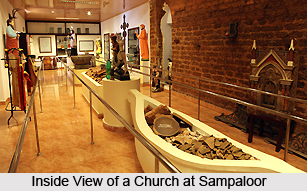 Sampaloor is located by the side of the Chalakudy River in Kerala. The place witnessed the arrival of a series of clergy like St. Francis Xavier, St. John Britto, Fr. Joseph Constantine Buski (Veeramamunivar) and Arnos Pathiri. Among them, the first to arrive at Sampaloor was St. Francis Xavier. He had come here via Marankuzhi, a place located in Kodungalloor (former Muziris).
Sampaloor is located by the side of the Chalakudy River in Kerala. The place witnessed the arrival of a series of clergy like St. Francis Xavier, St. John Britto, Fr. Joseph Constantine Buski (Veeramamunivar) and Arnos Pathiri. Among them, the first to arrive at Sampaloor was St. Francis Xavier. He had come here via Marankuzhi, a place located in Kodungalloor (former Muziris).
During the time of the Portuguese Sampaloor was an important center of Jesuits. Some of the structures can be seen here are the St. Paul`s Seminary, the St. Paul`s Monastery and the St. Paul`s Press and a church dedicated to St. Francis Xavier. These statues remind of the works of the Jesuits in Sampaloor. With time San-paul-ur became Sampaloor. St. John Britto, an Italian missionary, came to Sampaloor half way though the 17th century. He resided here for nearly one year. He studied Tamil language and Sanskrit language and adopted an Indian name - Swamy Arulananda. The altar of St. Francis Xavier`s church at which St. John Britto used to celebrate the holy mass is now a protected historical monument.
Arnos Pathiri, another member of the clergy studied at the St. Paul`s Seminary. He later got ordained there. Through his book `Puthen Pana.` he made remarkable contributions to the Malayalam literature. Fr. Joseph Constantine Buski (Veeramamunivar) had also settled here.
While serving in Madurai Mission he visited Sampaloor. He later lived here.
The first printing in Malayalam was done at the St. Paul`s Press in Sampaloor. This was set up by Jesuit Priests in 1663. The dictionary of `Prinsa Pathiri,` Tamil grammar of Dacosta Pathiri, and the books of Dinobili were printed in this press. Sampaloor was thus regarded as a great centre for language-nurturing.
Sampaloor was devastated in an attack by Tipu Sultan who was fighting the British during the middle periods of the 18th century. Later, the church got reconstructed during the time of Bernadian Bechinelly, who was the vicar apostolate of Varapuzha in 1862. The present church was blessed in 1979. However, it can be said that the arrival of the clergymen to Sampaloor in the mid 16th century and the expansion that took place can be counted as a part of the rich history of Kerala.
Historical Museum of Sampaloor
The Historical Museum of Sampaloor houses many objects when the place was the centre of Jesuit Mission. During their time there were St. Paul`s seminary, St, Paul`s Press, St. Paul`s Monastery, and St. Francis Xavier`s Church. The Cannon balls that were used during the time of Tippu, holy vestments of the priests of the Monastery, Tablets that describe the old liturgical order, instruments used to make the hosts, Tabernacle of theold church, statues of saints made of wood and metals, Lamps used for adoration, lamp-sticks, the Cross made of metal belongs to 15th century and ``Vazhuthayodukal" of the same century are some of the attractions of this Museum.



















